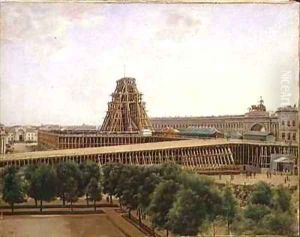Aleksandr Gavrilovich Denisov Paintings
Aleksandr Gavrilovich Denisov was a Soviet-era Russian artist, born in 1912 in the town of Kozmodemyansk, which is located in the Republic of Mari El, Russia. He was part of the generation of artists who came of age during the early Soviet period, a time when art was being used as a vehicle for socialist propaganda and when the state exerted significant control over artistic expression.
Denisov studied at the Kazan Art School from 1929 to 1932 and later at the Moscow State V.I. Surikov Art Institute, one of Russia's most prestigious art schools. His education coincided with the height of Socialist Realism, the official art style of the Soviet Union, which glorified the communist ideology, portraying the working class as heroic figures. Denisov's work was likely influenced by this style, though specific details of his oeuvre are not widely documented in English-language sources.
Throughout his career, Denisov would have been expected to conform to the Soviet Union's artistic standards. Artists during this period typically created works that depicted labor in a positive light, celebrated the achievements of the Soviet people, and idealized the leadership. Denisov would have worked during a period of significant historical events, including World War II, the Cold War, and the eventual dissolution of the Soviet Union in 1991.
Denisov's later years would have seen a transition as the Soviet Union began to collapse and the country opened up to a wider range of artistic expression. However, it is common for artists of this era who did not gain international recognition to have biographical details and records of their work lost or overshadowed by more prominent figures.
Aleksandr Gavrilovich Denisov passed away in 1994, a few years after the fall of the Soviet Union. His death marked the end of a life lived entirely under the Soviet regime, and his artistic legacy offers a glimpse into the complex world of Soviet art. Due to the scarcity of information, Denisov is not a well-known artist outside of Russia, and his work is primarily of interest to specialists in Soviet-era art and culture.
